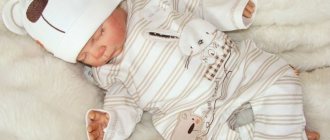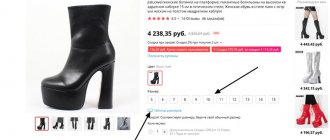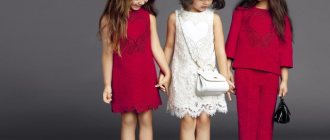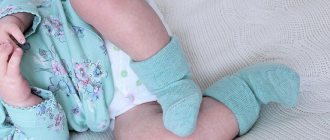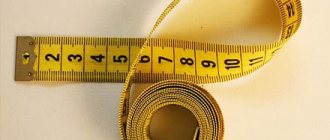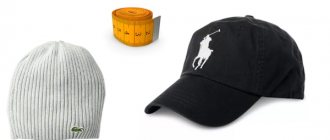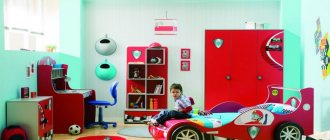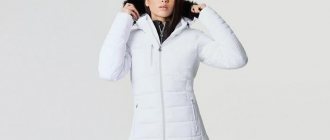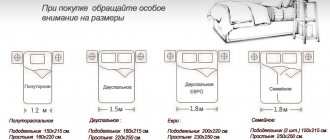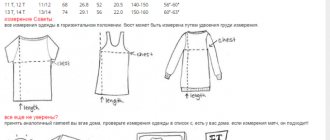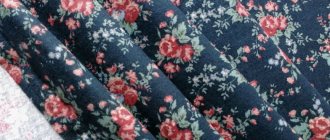Shoe size: table for children by age. If you need to buy your child new boots or sandals, parents, as a rule, take their child with them to the store. How else to choose shoes that fit so that they are not tight or, on the contrary, too loose. But what if beautiful shoes should become a pleasant surprise? How to make a purchase without a child so that the shoes fit? This is possible if you know the exact size.
How to determine a child's shoe size
To choose the “right” shoes, you need to take measurements of the child’s feet. First, an imprint of the foot is made, the beginning from the big toe and the end along the heel are recorded. Then you will need a tailor's meter or ruler. The distance between the extreme points of the foot image is measured. If the child is small and cannot walk yet, the foot is measured while the baby is sitting. Older preschoolers and schoolchildren's feet are measured while they are standing.
The most accurate measurements can be obtained if you measure your foot in the evening. By this time, the legs have increased slightly in size. Moreover, it is not enough to measure only, for example, the left foot. You will definitely need measurements on the right one too. As a rule, people have one leg that is slightly different from the other, a little larger. Shoe purchases should be made based on a larger size.
The data obtained should be compared with the generally accepted table of shoe sizes. This way you can understand what kind of shoes your child needs.
By the way, when choosing shoes, you need to pay attention to the fact that there should be a small distance between the big toe and the end of the sole, about half a centimeter. After all, a child walks and runs, and the foot moves as it moves, so boots or shoes bought in the same size will turn out to be tight, will rub their feet, and will quickly fail.
When choosing shoes, you should also consider fullness. The manufacturer always indicates what kind of foot the shoes are made for, for fat or thin, with high or low instep.
How to choose the right shoes for your child
You need to be extremely careful when choosing the very first shoes for your baby. Experts advise taking into account the following nuances:
- Boots must have flexible soles. It’s already difficult for a child to take his first steps, and if at the same time the hard material of the sole does not allow him to place his foot properly, it’s absolutely sad.
- Heavy boots are only suitable for special forces soldiers. For children, you need to choose lightweight models so that your legs don’t get tired when walking.
- Natural materials are required! Such shoes dry quickly, they are easy to wash and clean, and since kids are not very neat, this quality of footwear is necessary. However, mothers should remember that shoes can easily be damaged if they are dried directly next to a radiator: hot air will play a bad role - the insoles will become deformed, and the material from which the shoes are made will quickly become unusable.
- In babies, as a rule, the foot closer to the toes is wider than the heel. Therefore, you should not forget about this feature when choosing boots.
- Children often have a high instep. Therefore, when buying shoes for such kids, you need to choose models that are wide, but with a lock. The fixator will help to fix the foot in the shoe correctly, without dragging it.
- A shock absorber is required. High-quality children's boots are equipped with this feature.
- Shoes need to be selected according to size to avoid squelching. When a child walks in shoes that do not fit him, not only do his feet begin to form incorrectly, but he also develops clumsiness, which can become a habit, which will affect his gait and posture. In addition, fatigue appears in the legs, and the child begins to feel unwell.
When choosing shoes for your baby, you need to place the child’s foot tightly, moving it to the front of the shoe, and try to squeeze your finger between the heel and heel. If the toe fits in smoothly, but there is no more free space left, then the shoe fits correctly. The other shoe on the other foot is checked in the same way. Only after this verification can you make a purchase.
Country Size Charts
When choosing shoes, you need to take into account the labeling, because each country has its own canons.
In the CIS countries, Russia, European territory and China, the metric system has been introduced. That is, the size of the foot is calculated in millimeters. The sizes are approximately similar.
In the UK, the inch is used, so shoe sizes are calculated in inches. There are 25.4 millimeters per inch.
French shoemakers use touches. One stroke accounts for 2/3 of a centimeter. Moreover, you need to measure the insole.
In the USA, as well as in England, inches are used to measure. Foot measurements are taken.
Accordingly, the size table in different countries looks like this.
| England | USA | Europe | China |
| 0 | 1 | 16 | 9,5 |
| 0-1 | 1,2 | 16,5 | 10 |
| 1 | 2 | 17 | 10,5 |
| 1,5 | 2,5 | 18 | 11 |
| 2,5 | 3 | 19 | 11,5 |
| 3 | 4 | 19,5 | 12 |
| 4 | 5 | 20 | 12,5 |
| 4,5 | 5,5 | 21 | 13 |
| 5 | 6 | 22 | 13,5 |
| 5,5 | 6,5 | 22,5 | 14 |
| 6-6,5 | 7 | 23 | 14,5 |
| 7 | 8 | 24 | 15 |
| 7,5 | 8,5 | 25 | 15,5 |
| 8 | 9 | 25,5 | 16 |
| 8,5 | 9,5 | 26 | 16,5 |
| 9-9,5 | 10-10,5 | 27 | 17 |
| 10 | 11 | 28 | 17,5 |
| 10,5 | 11,5 | 28,5 | 18 |
| 11 | 12 | 29 | 18,5 |
| 11,5 | 12,5 | 30 | 19 |
| 12 | 13 | 31 | 19,5 |
| 12,5 | 13,5 | 31,5 | 20 |
| 13 | 1 | 32 | 20,5 |
| 1 | 1,5-2 | 33 | 21 |
| 1,5 | 2,5 | 34 | 21,5 |
| 2,5 | 3,5 | 35 | 22,5 |
Size system abroad
In some countries, the system for calculating children's shoe sizes may differ greatly from the usual Russian one. So, in Japan they use metric values (the size of children's shoes is measured in cm), in England and America the foot is measured in inches, but the step between sizes is different. Somewhere they measure the length of the insole, in another country the length of the foot, but with their own special calculation system. In order not to get confused in all this diversity and to correctly determine the size, the easiest way is to use a special table of size correspondence in different countries.
Shoe size: table for children by age in Russia
| Age | Size |
| From 3 months up to six months | 16; 16,5, 17 |
| From six months to 9 months. | 18; 19 |
| From 9 months up to a year | 19,5; 20 |
| From a year to a year and a half | 20-22 |
| From one and a half to 2 years | 22-23 |
| From 2 to 3 years | 23-25 |
| From 3 to 4 years | 25-26 |
| From 4 to 5 years | 26-28 |
| From 5 to 6 years | 28-30 |
| From 6 to 7 years | 30-31 |
| From 7 to 8 years | 31-32 |
| From 8 to 10 years | 33-35 |
For boys
Boys have a different physical development than girls; their feet grow faster. Therefore, the size table looks like this:
| Boy, age | Size |
| From 3 months to six months | 16; 16,5; 17 |
| From six months to 9 months. | 18; 19 |
| From 9 months up to a year | 19,5; 20 |
| From 12 months up to 18 months | 21; 22 |
| From 2 to 3 years | 22,5 |
| From 4 to 5 years | 25,5; 26 |
| From 5 to 6 years | 28; 28,5 |
| From 6 to 8 years | 30; 31 |
| From 8 to 12 years | 33; 34; 35; 36 |
Features of a child's foot
A child’s foot is formed before the age of 7-8 years. First of all, it should be understood that this is a physiological process that requires intervention only in emergency cases. Until this time, the muscles of the feet are not sufficiently developed, the cartilage tissue is imperfect, the foot has the necessary fat layer, which acts as a shock absorber. That’s why choosing the right shoes and complying with the size requirements is so important. In order not to miss the moment when the next pair becomes too small for the child, it is necessary to measure the baby’s feet periodically:
- For a child under 3 years old - once every two to three months.
- For a child 3-7 years old - once every 4-5 months.
Only by following the basic rules for choosing children's shoes can you be sure that nothing threatens the proper formation of a healthy foot.
Size chart by foot length
| Foot, length in centimeters | Size |
| 13 | 21 |
| 13,5 | 22 |
| 14 | 22,5 |
| 14,5 | 23 |
| 15 | 24 |
| 15,5 | 25 |
| 16 | 25,5 |
| 16,5 | 26 |
| 17 | 27 |
| 17,5 | 28 |
| 18 | 28,5 |
| 19 | 30 |
| 19,5 | 31 |
| 20 | 31,5 |
| 20,5 | 32 |
| 21 | 33 |
| 21,5 | 34 |
| 22 | 34,5 |
| 22,5 | 35 |
| 23 | 36 |
| 23,5 | 37 |
How to choose the size of your child's shoes
Each pair of shoes comes with manufacturer's information indicating which foot the shoe is suitable for. It's about completeness.
Thus, in European territory it is customary to indicate the fullness of shoes using Latin letters: C (very narrow), D (for thin feet), E (wider than D, but narrow), F (medium), G (fullness slightly more than average) , H (wide). It is worth noting that if the shoe is marked with the first three numbers, then it is not only a “small size”, but also has a low instep. Shoes marked H are for full feet with a high instep.
How to determine the fullness of the foot? You need to measure the widest gap between the contour of the foot.
It is recommended for younger preschoolers to buy shoes with a fullness of G. For boys, shoes with a fullness of G are usually selected, and for girls of a normal build - F.
Rules: how to choose shoes for a child
Parents who care about their child's health will never buy low-quality shoes. What moms and dads need to know when buying new products for children:
- For young children, you need to choose shoes made from hypoallergenic natural materials with good breathability.
- Boots for little ones should fit well around the ankle. These shoes will support the ankle joint.
- Shoes need to be purchased with a solid heel.
- The optimal heel size for children's shoes is 1.5 cm.
- For little ones, it is better to purchase shoes with ankle support.
- For younger preschoolers, it is recommended to buy closed shoes so that the toes do not stick out. This is a safety rule.
- Good shoes for children always have an orthopedic insole and shock absorber.
- The inner edges of children's shoes are straight.
In order not to make a mistake when choosing shoes, parents are advised to take into account several rules:
- Having trouble figuring out if your shoes are the right size? The easiest way is to take out the insole and measure your feet using it.
- Take foot measurements in advance and have them with you when visiting the store. The measurements will be useful if the insole cannot be removed from the shoe. Then the paper “foot” is inserted into a boot, shoe or sandal. You can tactilely determine whether the size fits or not.
- Use a finger test: place the baby’s foot in the shoe all the way forward, try to insert a finger between the heel and the heel. If your toe is tight, then your shoes are too tight. If there is a lot of free space, the shoes are too big.
Such checks will help you choose the right shoes.
Do you need stock?
This question is probably asked by all parents who have bought shoes for their child at least once in their life. A supply is needed, but not only, as many believe, so that the pair lasts for a long time. The reserve is also necessary to ensure that the leg is comfortable when walking, since this increases its length. The optimal supply depends on the shoes you purchase. For winter, the supply should be slightly larger. So that you can put it on a sock and still have enough space to form a so-called air cushion, which does not allow the child’s foot to freeze:
- For summer shoes, 0.6-0.8 cm is enough.
- For winter and demi-season, up to 1.5 cm is allowed.
Too little margin will prevent the foot from moving freely while walking; the child will simply instinctively curl his toes. Too much margin is fraught with distortion of gait, broken toes of shoes and improper formation of the arch of the foot if the model has an arch support.
How to understand that shoes are too small for a child
The child grows quickly, and accordingly his legs also grow, and his shoes have to be changed every now and then. Until children are three years old, shoes are changed almost once a month. For middle and older preschoolers, aged three to six years, shoes are selected regularly once every three months. Younger students will need to buy new shoes in size every five months.
To determine whether a child’s shoes are narrow or tight, you can carry out several manipulations:
- After the walk, examine the child's feet. If there is redness on the heel or toes, the shoes do not match the size.
- If, when pressing on the shoe, there is no room in the area of the big toe and the child’s toe rests, then the shoe is too tight.
- If the shoe begins to deform at the heel, then it is too small.
- If you have loose shoes on your feet, it is easy to slip your finger under the tongue. Otherwise the shoes are too small.
It is advisable to buy new shoes for your child. Of course, the financial status of families is different, however, when shoes from older children are “inherited” by the younger ones, this has a bad effect on the formation of the latter’s feet. The fact is that shoes that have already been worn involuntarily take on the shape of the feet of the first owner. As a result, a person who wears shoes is forced to adapt to someone else’s “pattern.” There you can get health problems.
And one more piece of advice: your child does not need to wear shoes always and everywhere. There must be a natural foot massage, which can be provided with the help of a massage mat, regular “walks” on sand, natural stones, and wood.
If the doctor determines that your child has flat feet, you need to take care and buy special orthopedic shoes. As a rule, such models are made from natural materials, with a rigid back, with a small - about one and a half centimeter - heel for stability and correct position of the foot. These shoes are equipped with arch support and good fasteners to ensure a snug fit of the shoe to the ankle.
Another requirement for shoes is that they should not get wet and should not allow the child’s feet to sweat. On sale you can find good quality models made from material impregnated with antibacterial agents and also absorbing excess moisture. The child will be comfortable in these shoes, selected to fit.
The fullness of the leg is also important
Russian manufacturers often forget that in order for the shoes to be suitable, not constrict the foot and not cause discomfort, attention must also be paid to the fullness of the child’s feet. In European countries, more attention is paid to this parameter; to measure completeness, special markings C, D, E, F, G, H are used, where C is the shoe for the foot with the most minimal fullness, H is for the maximum.
In the Russian shoe industry, fullness is often universal or depends on the model. In any case, if a child has wide feet, preference should be given to buying shoes in a store with mandatory fitting. You should not buy a model that is two sizes larger just because it fits fuller. It's better to spend a little more time and find the right one. How to correctly determine the size of children's shoes can be found above.
